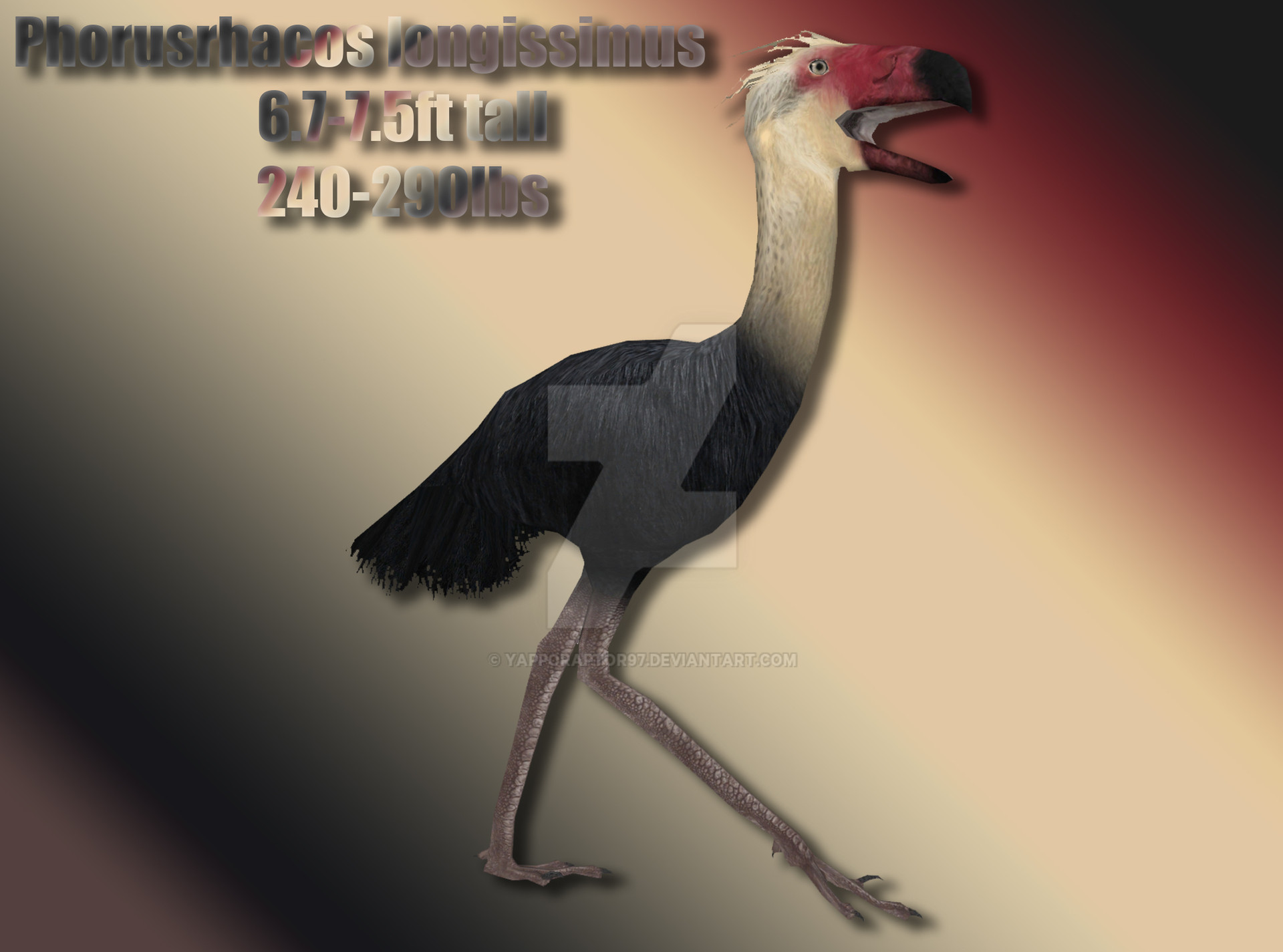HOME | DD
 Yapporaptor97 — Phorusrhacos Profile
Yapporaptor97 — Phorusrhacos Profile

#3dart #animals #argentina #birds #blender #digitalart #giantbird #megafauna #miocene #paleoart #photoshop #southamerica #wwb #zootycoon #zootycoon2 #extinctbirds #terrorbird #zt2 #terrorbirds #walkingwithbeasts #extinctlife #extinctanimal #extinctanimals #paleontology #prehistoriclife #paleoillustration #prehistoricbeasts #phorusrhachos #phorusrhachoslongissimus
Published: 2021-07-31 14:20:32 +0000 UTC; Views: 15513; Favourites: 76; Downloads: 1
Redirect to original
Description
Phorusrhacos longissimusSouth America is a land of oddballs. From sloths, to armadillos, to tapirs, to anteaters. The largest predator in South America, the Jaguar is around 320lbs and is a powerful predator. However, 15,000,000 years ago, a group of even more powerful predators ruled the plains and woodlands of South America. However, these were not mammals, they were birds. The Phorusrhacids, better known as “Terror Birds”, and probably most famous of all, was the type species: Phorusrhacos longissimus.
Terror birds and their niche(s):
Terror birds filled a variety of niches across the continent of South America filling a variety of niches on the continent. By the Miocene around 15,000,000 years ago, they had reached their apex, with animals from the massive and powerful Brontornis to the coyote-sized Psilopterus. Phorusrhacos was in the middle in terms of size. With a decently built body for a terror bird, powerful head and fairly long, yet sturdy legs, it was probably an animal that filled the niche of the wolf, leopard or puma in the modern world.
Description:
In terms of size, its rather hard to pin down exactly since fossils of these animals are rather fragmentary. However, many paleontologists think that it was around 7.5ft tall, weighed around 240-290lbs, and the skull was ~26in long.
History ofDiscovery:
It was discovered by Florentine-Argentine Paleontologist Carlos Ameghino in 1887. One of the foremost paleontologists in Argentina at the time. The holotype specimen was a fragmentary lower mandible. He recognized from the way the jaw was structured and the porous nature of the bone structure that it was a bird. He named the animal Phorusrhacos longissimus. The genus name derived from the Greek, “phoros” meaning “bearer” and “rhakos” meaning rag. Possibly a reference to the wrinkly texture of the holotype’s jaw. The species name is derived from the Latin meaning “very long”.
Fossils of this animal are relatively incomplete with it being known only from Argentina from the mid to late Miocene from 20-13,000,000 years ago. A leg bone of this animal has been found and while it was still robust compared to its smaller cousins, it was somewhat slimmer than its more iconic kin like Titanis or Kelenken. Suggesting it was probably more cursorial than its more robust cousins. Meaning its habitat was more along the lines of open grassland.
Habitat and Habits:
For a long time, Phorusrhacids were thought to have preyed on smaller prey across South America. However, it is now known that these birds, while some did prey upon smaller animals, larger birds preyed upon larger megafauna. With animals like Phorusrhacos probably preying on medium-sized prey like the Notoungulates or smaller ground sloths of South America.
This was extrapolated from a study in 2010. The study found that they’d have to hold onto prey when killing them, and while their feet could have been adept to handling prey, their skull was poorly built to handling torsion (side-to-side) forces. So they could not have used it to restrain struggling prey. However, their beaks were well developed for delivering hammer-like blows to animals. It’s suggested that animals with the build of Phorusrhacos used their skull like a sledgehammer, it’s long yet sturdy neck would drive its hooked beak into the back. The blows dealing tremendous trauma to the prey animal and if hit in the right spot could cause paralysis. They probably would then feed upon the animal in a similar manner like hawks and eagles using quick nipping actions at the prey.
Extinction:
The Miocene of South America was when these birds were at their most diverse. The giant Brontornis filled the niche of the tiger, the agile Andalgalornis filled the niche of the cheetah, and Phorusrhacos itself filled a niche of somewhere in between. These animals would dominate South America and (eventually) southern North America till around 1,800,000 years when the larger terror birds would vanish from the New World altogether.
___________________________________________________________________________________________
Okay, apologies for my inactivity. A new job, PMP, computer problems resulting in part of the outline for PMP being lost, and a new PC to get everything transferred over has been on my plate these past 2 weeks.
Anyways, here's another profile for y'all. Now, I think you can see some problems. I know the legs (even though they are somewhat slimmer than other larger Terror Birds) are too slim, but it's really the only model I can use for this profile. I've tried to modify the files in blender, but the legs distort severely. An acquaintance online is working on another model, so if he makes progress with that, I'll do an update.
Will this be in Past Meets Present? No. I decided beforehand that South/Central America could be on the list, BUT I've already selected a Miocene location.
Original Model and Skin by Demon Hunter:
Phorusrhacos (Demon Hunter) | ZT2 Download Library Wiki | Fandom
Related content
Comments: 12

👍: 0 ⏩: 0

👍: 0 ⏩: 0

👍: 0 ⏩: 0

👍: 0 ⏩: 2

👍: 0 ⏩: 1

👍: 0 ⏩: 1

👍: 0 ⏩: 0

👍: 0 ⏩: 1

👍: 0 ⏩: 1

👍: 0 ⏩: 1

👍: 1 ⏩: 1

👍: 0 ⏩: 0




















